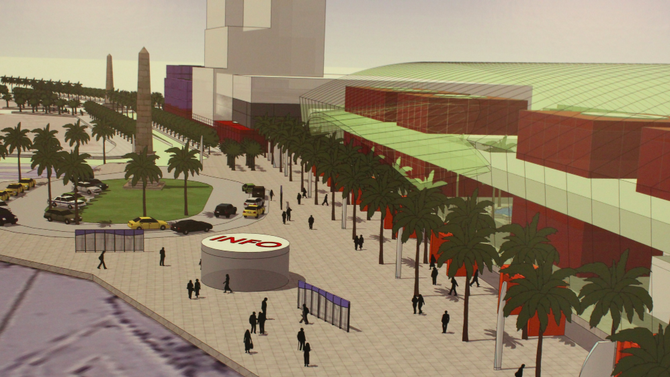 Facebook
Facebook
 X
X
 Instagram
Instagram
 TikTok
TikTok
 Youtube
Youtube

The San Ysidro Community Planning Group held a special meeting on July 10 at the Colonel Irving Salomon Community Activity Center to receive input from residents and business owners about land-use plans for the border community.
According to the presentation given by Sara Osborn of the City of San Diego and Jami Williams of RRM Design Group, a redevelopment plan was adopted for San Ysidro in 1991 that does not address the current needs of the community.
With the help of city officials and design consultants, an advisory committee has worked toward a new plan. Their proposal would change building-height restrictions from 24 feet to between 30 and 100 feet, and commercial-only areas would become mixed-use zones.
The proposed plan would take the existing 5 million square feet of commercial development and increase it to 11.7 million square feet of future development. The residential component would increase from the existing 11,350 residential units to 15,680. Park land would increase from the current 35 acres to 174 acres.
Leo Espelet from Kimley-Horn and Associates gave a traffic analysis based on his work with SANDAG.
“When we go to the proposed plan, there are a lot more improvements to accommodate future traffic intensity,” said Espelet. At the border, the existing roads accommodate 30,000 vehicle trips per day; the proposed plan would accommodate about 150,000 trips per day.
In reaction to the presentation, a community member said, “This community has been underserved, and I get the feeling that we’re supposed to now reduce our expectations and goals based on the assumption that the city will continue to underserve our streets and roads. I would propose that this whole community planning process do just the opposite; this is our opportunity to show our improvement potential and demand from the city what we need.”
Rachel Kennedy from SANDAG then displayed two architectural options for a new International Transportation Center at the San Ysidro trolley station. Both options include large parking lots, several bus lines, pedestrian-only sidewalks, and retail stores.
“Both of these options are fatally flawed,” community member Miguel Aguirre said. “This, overall, does not uplift the community. It’s really a big glorified trolley station. What we have now is buses, vehicles, and a trolley all conflicting at the same level and they’re still doing that in this plan….
“I feel the trolley needs to serve the community. It needs to be back at the gateway to really allow for any future development. This takes the best part of the property and puts a trolley on it, which is not the highest and best use. If you’re going to attract private investment, you need to give an opportunity to create a destination that is going to bring people to San Ysidro, to uplift not only the community, but this location as a national gateway… There are a lot of things that are missing to make this a world-class project.”


The San Ysidro Community Planning Group held a special meeting on July 10 at the Colonel Irving Salomon Community Activity Center to receive input from residents and business owners about land-use plans for the border community.
According to the presentation given by Sara Osborn of the City of San Diego and Jami Williams of RRM Design Group, a redevelopment plan was adopted for San Ysidro in 1991 that does not address the current needs of the community.
With the help of city officials and design consultants, an advisory committee has worked toward a new plan. Their proposal would change building-height restrictions from 24 feet to between 30 and 100 feet, and commercial-only areas would become mixed-use zones.
The proposed plan would take the existing 5 million square feet of commercial development and increase it to 11.7 million square feet of future development. The residential component would increase from the existing 11,350 residential units to 15,680. Park land would increase from the current 35 acres to 174 acres.
Leo Espelet from Kimley-Horn and Associates gave a traffic analysis based on his work with SANDAG.
“When we go to the proposed plan, there are a lot more improvements to accommodate future traffic intensity,” said Espelet. At the border, the existing roads accommodate 30,000 vehicle trips per day; the proposed plan would accommodate about 150,000 trips per day.
In reaction to the presentation, a community member said, “This community has been underserved, and I get the feeling that we’re supposed to now reduce our expectations and goals based on the assumption that the city will continue to underserve our streets and roads. I would propose that this whole community planning process do just the opposite; this is our opportunity to show our improvement potential and demand from the city what we need.”
Rachel Kennedy from SANDAG then displayed two architectural options for a new International Transportation Center at the San Ysidro trolley station. Both options include large parking lots, several bus lines, pedestrian-only sidewalks, and retail stores.
“Both of these options are fatally flawed,” community member Miguel Aguirre said. “This, overall, does not uplift the community. It’s really a big glorified trolley station. What we have now is buses, vehicles, and a trolley all conflicting at the same level and they’re still doing that in this plan….
“I feel the trolley needs to serve the community. It needs to be back at the gateway to really allow for any future development. This takes the best part of the property and puts a trolley on it, which is not the highest and best use. If you’re going to attract private investment, you need to give an opportunity to create a destination that is going to bring people to San Ysidro, to uplift not only the community, but this location as a national gateway… There are a lot of things that are missing to make this a world-class project.”
Comments